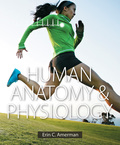
EBK HUMAN ANATOMY & PHYSIOLOGY
16th Edition
ISBN: 8220100659836
Author: AMERMAN
Publisher: PEARSON
expand_more
expand_more
format_list_bulleted
Textbook Question
Chapter 19.3, Problem 7QC
How do the lymphoid and myeloid cell lines differ?
Expert Solution & Answer
Trending nowThis is a popular solution!

Students have asked these similar questions
Generate one question that requires a Punnet Squre to solve the question. Then show how you calculate the possibilities of genotype and phenotype
Briefly state the physical meaning of the electrocapillary equation (Lippman equation).
Explain in a small summary how:
What genetic information can be obtained from a Punnet square? What genetic information cannot be determined from a Punnet square?
Why might a Punnet Square be beneficial to understanding genetics/inheritance?
Chapter 19 Solutions
EBK HUMAN ANATOMY & PHYSIOLOGY
Ch. 19.1 - Prob. 1QCCh. 19.1 - Prob. 2QCCh. 19.1 - 3. How does blood regulate temperature and...Ch. 19.1 - 4. What are the four main categories of plasma...Ch. 19.1 - Prob. 5QCCh. 19.2 - Describe the structure of a typical erythrocyte.Ch. 19.2 - Prob. 2QCCh. 19.2 - 3. Walk through the basic steps of...Ch. 19.2 - 4. What is the lifespan of an erythrocyte?
Ch. 19.2 - Prob. 5QC
Ch. 19.2 - Prob. 6QCCh. 19.2 - Prob. 7QCCh. 19.3 - How do granulocytes and agranulocytes differ?Ch. 19.3 - Prob. 2QCCh. 19.3 - Compare the two types of agranulocytes.Ch. 19.3 - 4. How do B and T lymphocytes differ?
Ch. 19.3 - 5. What does a monocyte become in the tissues?...Ch. 19.3 - Prob. 6QCCh. 19.3 - 7. How do the lymphoid and myeloid cell lines...Ch. 19.3 - 8. Where do T and B lymphocytes mature?
Ch. 19.4 - Prob. 1QCCh. 19.4 - Prob. 2QCCh. 19.5 - Prob. 1QCCh. 19.5 - Prob. 2QCCh. 19.5 - 3. How are platelets triggered to aggregate?
Ch. 19.5 - Prob. 4QCCh. 19.5 - How do the intrinsic/contact activation and...Ch. 19.5 - Prob. 6QCCh. 19.5 - Prob. 7QCCh. 19.5 - What is thrombolysis?Ch. 19.5 - Prob. 9QCCh. 19.5 - Prob. 10QCCh. 19.5 - Prob. 11QCCh. 19.5 - Prob. 12QCCh. 19.5 - Prob. 13QCCh. 19.5 - Prob. 14QCCh. 19.6 - Prob. 1QCCh. 19.6 - Prob. 2QCCh. 19.6 - Prob. 3QCCh. 19.6 - Prob. 4QCCh. 19.6 - Prob. 5QCCh. 19 - Prob. 1CYRCh. 19 - Prob. 2CYRCh. 19 - List the seven major functions of blood.Ch. 19 - Prob. 4CYRCh. 19 - Prob. 5CYRCh. 19 - Prob. 6CYRCh. 19 - Prob. 7CYRCh. 19 - Leukocytes are: a. nucleated cells that function...Ch. 19 - Prob. 9CYRCh. 19 - Fill in the blanks: Lymphocytes are derived from...Ch. 19 - Prob. 11CYRCh. 19 - Number the steps of hemostasis in order, putting 1...Ch. 19 - Prob. 13CYRCh. 19 - Prob. 14CYRCh. 19 - Prob. 15CYRCh. 19 - Prob. 16CYRCh. 19 - Prob. 17CYRCh. 19 - 18. Which antigens does a person with blood type...Ch. 19 - Prob. 19CYRCh. 19 - Prob. 20CYRCh. 19 - 1. Explain how blood, being a liquid, enables all...Ch. 19 - Prob. 2CYUCh. 19 - 3. The anticoagulant drug warfarin primarily...Ch. 19 - 4. Cirrhosis of the liver often reduces production...Ch. 19 - 1. A blood sample from your patient shows that she...Ch. 19 - Prob. 2AYKACh. 19 - Prob. 3AYKACh. 19 - Prob. 4AYKB
Knowledge Booster
Learn more about
Need a deep-dive on the concept behind this application? Look no further. Learn more about this topic, biology and related others by exploring similar questions and additional content below.Similar questions
- In a small summary write down:arrow_forwardNot part of a graded assignment, from a past midtermarrow_forwardNoggin mutation: The mouse, one of the phenotypic consequences of Noggin mutationis mispatterning of the spinal cord, in the posterior region of the mouse embryo, suchthat in the hindlimb region the more ventral fates are lost, and the dorsal Pax3 domain isexpanded. (this experiment is not in the lectures).a. Hypothesis for why: What would be your hypothesis for why the ventral fatesare lost and dorsal fates expanded? Include in your answer the words notochord,BMP, SHH and either (or both of) surface ectoderm or lateral plate mesodermarrow_forward
arrow_back_ios
SEE MORE QUESTIONS
arrow_forward_ios
Recommended textbooks for you
 Biology (MindTap Course List)BiologyISBN:9781337392938Author:Eldra Solomon, Charles Martin, Diana W. Martin, Linda R. BergPublisher:Cengage Learning
Biology (MindTap Course List)BiologyISBN:9781337392938Author:Eldra Solomon, Charles Martin, Diana W. Martin, Linda R. BergPublisher:Cengage Learning Human Biology (MindTap Course List)BiologyISBN:9781305112100Author:Cecie Starr, Beverly McMillanPublisher:Cengage Learning
Human Biology (MindTap Course List)BiologyISBN:9781305112100Author:Cecie Starr, Beverly McMillanPublisher:Cengage Learning Biology 2eBiologyISBN:9781947172517Author:Matthew Douglas, Jung Choi, Mary Ann ClarkPublisher:OpenStax
Biology 2eBiologyISBN:9781947172517Author:Matthew Douglas, Jung Choi, Mary Ann ClarkPublisher:OpenStax Human Physiology: From Cells to Systems (MindTap ...BiologyISBN:9781285866932Author:Lauralee SherwoodPublisher:Cengage Learning
Human Physiology: From Cells to Systems (MindTap ...BiologyISBN:9781285866932Author:Lauralee SherwoodPublisher:Cengage Learning


Biology (MindTap Course List)
Biology
ISBN:9781337392938
Author:Eldra Solomon, Charles Martin, Diana W. Martin, Linda R. Berg
Publisher:Cengage Learning

Human Biology (MindTap Course List)
Biology
ISBN:9781305112100
Author:Cecie Starr, Beverly McMillan
Publisher:Cengage Learning

Biology 2e
Biology
ISBN:9781947172517
Author:Matthew Douglas, Jung Choi, Mary Ann Clark
Publisher:OpenStax

Human Physiology: From Cells to Systems (MindTap ...
Biology
ISBN:9781285866932
Author:Lauralee Sherwood
Publisher:Cengage Learning

Cell Differentiation | Genetics | Biology | FuseSchool; Author: FuseSchool - Global Education;https://www.youtube.com/watch?v=gwAz_BtVuLA;License: Standard YouTube License, CC-BY